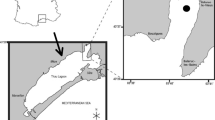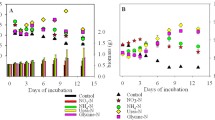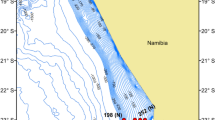Abstract
Mussels (Bathymodiolus sp., undescribed) that contain endosymbiotic methanotrophic bacteria were collected from the vicinity of hydrocarbon seeps on the Louisiana Slope of the Gulf of Mexico during September 1989 and 1991. In the presence of methane, these mussels took up ammonium and free amino acids (FAA) but not nitrate. Rates of ammonium uptake ranged from 0.11 to 0.78 μmolg-1 h-1 following initial concentrations of 3.7 to 140.0 μM. The relationship between uptake rate and ammonium concentration exhibited by these mussels appears to be non-linear, apparently differing from the linear kinetics exhibited by algal-invertebrate symbioses. Alanine and glycine were depleted from the medium by symbiotic mussels at rates of 0.10 and 0.07 μmolg-1 h-1 following initial concentrations of 1 μM. Given estimates of rates of carbon fixation and ammonium and FAA levels encountered by the mussels in situ, it is likely that ammonium uptake can meet the nitrogen needs of the association, and that acquisition of carbon and nitrogen from FAA uptake may be an important supplement.
Similar content being viewed by others
Literature cited
Anderson, A. E., Childress, J. J., Favuzzi, J. A. (1987). Net uptake of CO2 driven by sulphide and thiosulphate oxidation in the bacterial symbiont-containing clam Solemya reidi. J. exp. Biol. 133: 1–31
Anthony, C. (1982). The biochemistry of methylotrophs. Academic Press, London
Bayne, B. L. (1973). Physiological changes in Mytilus edulis L. induced by temperature and nutritive stress. J. mar. biol. Ass. U. K. 53: 39–58
Bidwell, J. P., Spotte, S. (1985). Artificial seawaters. Jones & Bartlett, Woods Hole
Brooks, J. M., Kennicutt II, M. C., Fisher C. R., Macko, S. A., Cole, K., Childress, J. J. Bidigare, R. R., Vetter, R. D. (1987). Deep-sea hydrocarbon seep communities: evidence for energy and nutritional carbon sources. Science, N. Y. 238: 1138–1142
Cary, S. C., Fisher, C. R., Felbeck, H. (1988). Mussel growth supported by methane as sole carbon and energy source. Science, N.Y. 240: 78–80
Childress, J. J., Arp, A. J., Fisher, C. R., Jr. (1984). Metabolic and blood characteristics of the hydrothermal vent tube-worm Riftia pachyptila. Mar. Biol. 83: 109–124
Childress, J. J., Fisher, C. R., Brooks, J. M., Kennicutt II, M. C., Bidigare, R., Anderson, A. E. (1986). A methanotrophic marine molluscan (Bivalvia, Mytilidae) symbiosis: mussels fueled by gas. Science, N. Y. 233: 1306–1308
D'Elia, C. F., Cook, C. B. (1988). Methylamine uptake by zooxanthellae-invertebrate symbioses: insights into host ammonium environment and nutrition. Limnol. Oceanogr 33: 1153–1165
D'Elia, C. F., Domotor, S. L., Webb, K. L. (1983). Nutrient uptake kinetics of freshly isolated zooxanthelae. Mar. Biol. 75: 157–167
Fisher, C. R., Childress, J. J., Arp, A. J., Brooks, J. M., Distel, D., Favuzzi, J. A., Felbeck, H., Fritz, L. W., Hessler, R. R., Johnson, K. S., Kennicutt II, M. C., Lutz, R. A., Macko, S. A., Newton, A., Powell, M. A., Somero, G. N., Soto, T. (1988a). Variation in the hydrothermal vent clam, Calyptogena magnifica, at the Rose Garden vent on the Galapagos spreading center. Deep-Sea Res. 35: 1811–1831
Fisher, C. R., Childress, J. J., Arp, A. J., Brooks, J. M., Distel, D., Favuzzi, J. A., Felbeck, H., Hessler, R., Johnson, K. S., Kennicutt II, M. C., Macko, S. A., Newton, A., Powell, M. A., Somero, G. N., Soto, T. (1988b). Microhabitat variation in the hydrothermal vent mussel, Bathymodiolus thermophilus, at the Rose Garden vent on the Galapagos Rift. Deep-Sea Res. 35: 1769–1791
Fisher, C. R., Childress, J. J., Arp, A. J., Brooks, J. M., Distel, D., Favuzzi, J. A., Macko, S. A., Newton, A., Powell, M. A., Somero, G. N., Soto, T. (1988c). Physiology, morphology, and biochemical composition of Riftia pachyptila at Rose Garden in 1985. Deep-Sea Res. 35: 1745–1758
Fisher, C. R., Childress, J. J., Oremland, R. S., Bidigare, R. R. (1987). The importance of methane and thiosulfate in the metabolism of the bacterial symbionts of two deep-sea mussels. Mar. Biol. 96: 59–71
Fubrman, J. A., Bell, T. M. (1985). Biological considerations in the measurement of dissolved free amino acids in seawater and implications for chemical and microbiological studies. Mar. Ecol. Prog. Ser. 25: 13–21
Guerrero, M. G., Vega, J. M., Losada, M. (1981). The assimilatory nitrate reducing system and its regulation. A. Rev. Pl. Physiol. 32: 169–204
Hipkin, C. R., Al-Bassam, B. A. R., Syrett, P. J. (1980). The roles of nitrate and ammonium in the regulation of the development of nitrate reductase in Chlamydomonas reinhardii. Planta 150: 13–18
Hochman, A., Nissany, A., Amizur, M. (1988). Nitrate reduction and assimilation by a moderately halophilic, halotolerant bacterium Ba1. Biochim. biophys. Acta 965: 82–89
Johnson, K. S., Petty, R. L. (1983). Determination of nitrate and nitrite in seawater by flow injection analysis. Limnol. Oceanogr. 28: 1260–1266
Kennicutt, M. C. II, Brooks, J. M., Burke, R. A., Jr. (1989). Hydrocarbon seepage, gas hydrates, and authigenic carbonate in the Northwestern Gulf of Mexico. Offshore Technology Conference, Houston, Texas, p. 649–654. (Offshore Technology Conference Paper No. 5952)
Kochevar, R. E., Childress, J. J., Fisher, C. R., Minnich, E. (1992). The methane mussel: roles of symbiont and host in the metabolic utilization of methane. Mar. Biol. 112: 389–401
Lee, R. W., Thuesen, E. V., Childress, J. J. (1992). Ammonium and free amino acids as nitrogen sources for the chemoautotrophic symbiosis Solemya reidi Bernard (Bivalvia: Protobranchia). J. exp. mar. Biol. Ecol. (in press)
Lindroth, P., Mopper, K. (1979). High performance liquid chromatographic determination of subpicomole amounts of amino acids by precolumn fluorescence derivitization. Analyt. Chem. 51: 1667–1674
MacDonald, I. R., Boland, G. S., Baker, J. S., Brooks, J. M., Kennicutt, M. C. II, Bidigare, R. R. (1989). Gulf of Mexico hydrocarbon seep communities. II. Spatial distribution of seep organisms and hydrocarbons at Bush Hill. Mar. Biol. 101: 235–247
MacDonald, I. R., Reilly, J. F., Guinasso, N. L., Brooks, J. M., Carney, R. S., Bryant, W. A., Bright, T. J. (1990). Chemosynthetic mussels at a brine-filled pockmark in the Northern Gulf of Mexico. Science, N.Y. 248: 1096–1099
Mopper, K., Lindroth, P. (1982). Diel and depth aariations in dissolved free amino acids and ammonium in the Baltic Sea determined by shipboard HPLC analysis. Limnol. Oceanogr. 27: 337–347
Page, H. M., Fisher, C. R., Childress, J. J. (1990). Role of filter-feeding in the nutritional biology of a deep-sea mussel with methanotrophic symbionts. Mar. Biol. 104: 251–257
Porter, K. G., Feig, Y. S. (1980). The use of DAPI for identifying and counting aquatic microflora. Limnol. Oceanogr. 25: 943–948
Seiderer, L. J., Newell, R. C. (1985). Relative significance of phytoplankton, bacteria and plant detritus as carbon and nitrogen resources for the kelp bed filter-feeder Choromytilus meridionalis. Mar. Ecol. Prog. Ser. 22: 127–139
Syrett, P. J. (1981). Nitrogen metabolism of microalgae. Can Bull. Fish. aquat.. Sciences. 210: 182–210
Turpin, D. H., Edie, S. A., Canvin, D. T. (1984). In vivo, nitrogenase regulation by ammonium and methylamine and the effect of MSX on ammonium transport in Anabaena flos-aquae. Pl. Physiol. 74: 701–704
Whifield, M. (1974). The hydrolysis of ammonium ions in seawater — a theoretical study. J. mar. biol. Ass. U. K. 54: 565–580
Wilkerson, F. P., Muscatine, L. (1984). Uptake and assimilation of dissolved inorganic nitrogen by a symbiotic sea anemone. Proc. R. Soc. (Ser. B) 221: 71–86
Wilkerson, F. P., Trench, R. K. (1986). Uptake of dissolved inorganic nitrogen by the symbiotic clam Tridacna gigas and the coral Acropora sp. Mar. Biol. 93: 237–246
Willason, S. W., Johnson, K. S. (1986). A rapid, highly sensitive technique for the determination of ammonia in seawater. Mar. Biol. 91: 285–290
Author information
Authors and Affiliations
Additional information
Communicated by M. G. Hadfield, Honolulu
Rights and permissions
About this article
Cite this article
Lee, R.W., Thuesen, E.V., Childress, J.J. et al. Ammonium and free amino acid uptake by a deep-sea mussel (Bathymodiolus sp., undescribed) containing methanotrophic bacterial symbionts. Marine Biology 113, 99–106 (1992). https://doi.org/10.1007/BF00367643
Accepted:
Issue Date:
DOI: https://doi.org/10.1007/BF00367643




